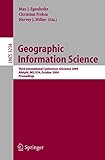Geographic Information Science [electronic resource] : Third International Conference, GI Science 2004 Adelphi, MD, USA, October 20-23, 2004 Proceedings /
Material type: TextSeries: Lecture Notes in Computer Science ; 3234Publisher: Berlin, Heidelberg : Springer Berlin Heidelberg : Imprint: Springer, 2004Edition: 1st ed. 2004Description: VIII, 348 p. online resourceContent type:
TextSeries: Lecture Notes in Computer Science ; 3234Publisher: Berlin, Heidelberg : Springer Berlin Heidelberg : Imprint: Springer, 2004Edition: 1st ed. 2004Description: VIII, 348 p. online resourceContent type: - text
- computer
- online resource
- 9783540302315
- Geographic information systems
- Database management
- Application software
- Information storage and retrieval systems
- Multimedia systems
- Earth sciences
- Geographical Information System
- Database Management
- Computer and Information Systems Applications
- Information Storage and Retrieval
- Multimedia Information Systems
- Earth Sciences
- 910.285 23
- G70.212-.217
Contested Nature of Place: Knowledge Mapping for Resolving Ontological Distinctions Between Geographical Concepts -- Geo-Self-Organizing Map (Geo-SOM) for Building and Exploring Homogeneous Regions -- Can Relative Adjacency Contribute to Space Syntax in the Search for a Structural Logic of the City? -- Semi-automatic Ontology Alignment for Geospatial Data Integration -- Modeling Surface Hydrology Concepts with Endurance and Perdurance -- Procedure to Select the Best Dataset for a Task -- Floating-Point Filter for the Line Intersection Algorithm -- Project Lachesis: Parsing and Modeling Location Histories -- The SPIRIT Spatial Search Engine: Architecture, Ontologies and Spatial Indexing -- Comparing Exact and Approximate Spatial Auto-regression Model Solutions for Spatial Data Analysis -- 3D GIS for Geo-coding Human Activity in Micro-scale Urban Environments -- Arc_Mat, a Toolbox for Using ArcView Shape Files for Spatial Econometrics and Statistics -- A Predictive Uncertainty Model for Field-Based Survey Maps Using Generalized Linear Models -- Information Dissemination in Mobile Ad-Hoc Geosensor Networks -- Public Commons of Geographic Data: Research and Development Challenges -- Alternative Buffer Formation -- Effect of Category Aggregation on Map Comparison -- Simplifying Sets of Events by Selecting Temporal Relations -- Towards a Temporal Extension of Spatial Allocation Modeling -- Formalizing User Actions for Ontologies -- Landmarks in the Communication of Route Directions -- From Objects to Events: GEM, the Geospatial Event Model.
This section gives a description of notions used throughout this study. Current achievements in developing action-centered ontologies are also discussed. 2.1 Ontologies In the context of information extraction and retrieval, different kinds of ontologies can be distinguished [15]: • Top-level ontologies describe very general concepts like space and time, not depending on a particular domain, • Domain ontologies and task ontologies describe the vocabulary related to a generic domain or kind of task, detailing the terms used in the top-level ontology, • Application ontologies describe the concepts that depend on the particular domain and task within a specific activity. Several investigations have been conducted to bring actions (tasks) to bear on - tologies. Among them are Chandrasekaran et al. [6] and Mizoguchi et al. [23] in the fields of AI and Knowledge Engineering. For the geospatial domain, Kuhn [21] and Raubal and Kuhn [26] have attempted to support human actions in ontologies for transportation. Acknowledging the importance of human actions in the geographic domain, a research workshop was held in 2002, bringing together experts from diff- ent disciplines to share the knowledge and work on this issue [1]. Camara [5], one of the workshop participants, has proposed that action-driven spatial ontologies are formed via category theory, for the case of emergency action plans.


There are no comments on this title.